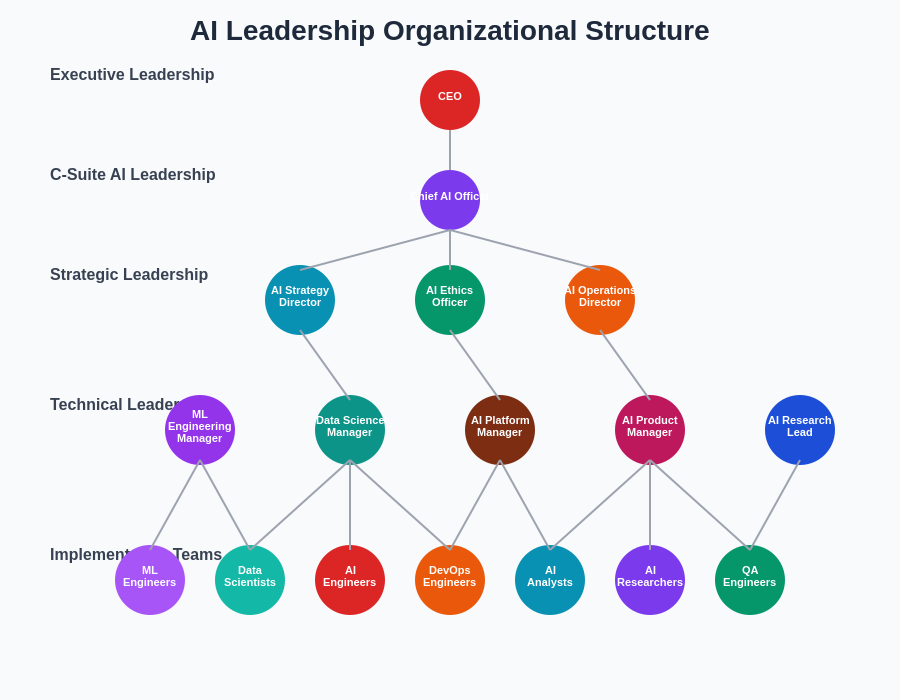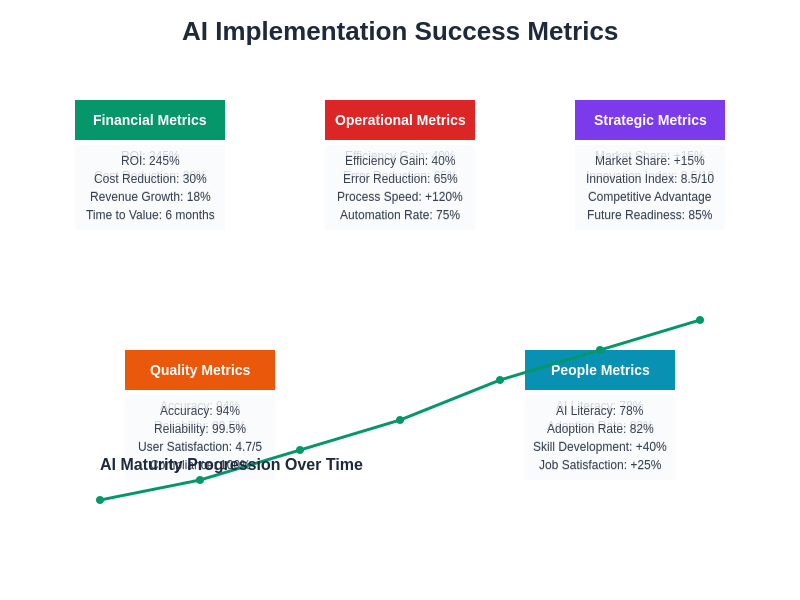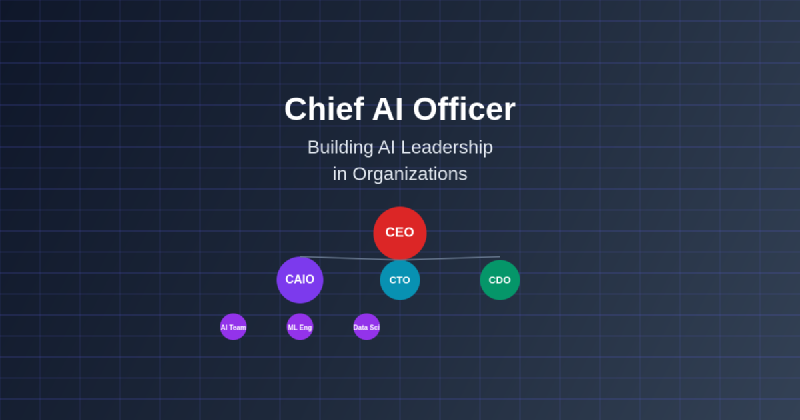The rapid advancement of artificial intelligence has created an unprecedented demand for specialized leadership within organizations, giving rise to one of the most significant executive roles of the digital age: the Chief AI Officer. This emerging position represents far more than a technological appointment; it embodies the strategic imperative for organizations to harness artificial intelligence as a transformative force that can reshape entire industries, redefine competitive advantages, and fundamentally alter how businesses operate in an increasingly AI-driven marketplace.
Stay updated with the latest AI leadership trends as organizations worldwide recognize the critical importance of dedicated AI leadership in navigating the complex landscape of artificial intelligence adoption and implementation. The Chief AI Officer role has evolved from a novel concept to an essential executive position that bridges the gap between technological possibility and business reality, ensuring that AI initiatives deliver tangible value while maintaining ethical standards and regulatory compliance.
The Evolution of AI Leadership
The emergence of the Chief AI Officer position reflects the maturation of artificial intelligence from experimental technology to mission-critical business capability. Organizations initially approached AI implementation through fragmented initiatives led by various departments, often resulting in duplicated efforts, inconsistent strategies, and suboptimal outcomes. The recognition that AI requires dedicated, centralized leadership has led to the rapid adoption of the Chief AI Officer role across industries ranging from healthcare and financial services to manufacturing and retail.
This evolution represents a fundamental shift in how organizations approach digital transformation and technological innovation. The Chief AI Officer serves as the primary architect of an organization’s AI vision, responsible for translating complex technological capabilities into strategic business advantages while ensuring that AI implementations align with organizational values, regulatory requirements, and long-term objectives. The role demands a unique combination of technical expertise, business acumen, and leadership capabilities that can navigate the intricate challenges of enterprise-scale AI deployment.
The increasing complexity of AI technologies, coupled with their profound impact on business operations and competitive positioning, has made the Chief AI Officer role indispensable for organizations seeking to leverage artificial intelligence effectively. This position represents the convergence of technological innovation and strategic leadership, creating a new paradigm for how organizations approach AI adoption and implementation.
Defining the Chief AI Officer Role
The Chief AI Officer occupies a unique position within the executive hierarchy, serving as both a strategic visionary and operational executor responsible for orchestrating comprehensive AI initiatives across the organization. Unlike traditional technology roles that focus primarily on system implementation and maintenance, the Chief AI Officer must possess a multifaceted skill set that encompasses strategic planning, risk management, ethical governance, and change management capabilities.
The role encompasses responsibility for developing and executing comprehensive AI strategies that align with organizational objectives while identifying opportunities for AI-driven innovation and competitive advantage. Chief AI Officers must navigate the complex landscape of AI technologies, vendor relationships, regulatory compliance, and organizational change management while ensuring that AI initiatives deliver measurable business value and maintain the highest standards of ethical implementation.
Enhance your AI leadership capabilities with Claude to develop strategic insights and analytical skills essential for effective AI governance and implementation. The Chief AI Officer must serve as a bridge between technical teams and executive leadership, translating complex AI concepts into actionable business strategies while ensuring that all stakeholders understand the implications and potential of artificial intelligence initiatives.
Strategic Responsibilities and Core Functions
The strategic responsibilities of a Chief AI Officer extend far beyond technology implementation to encompass comprehensive organizational transformation that touches every aspect of business operations. These leaders must develop long-term AI roadmaps that anticipate technological developments, regulatory changes, and market dynamics while ensuring that AI initiatives support overall business objectives and create sustainable competitive advantages.
Chief AI Officers are responsible for identifying and prioritizing AI use cases that offer the greatest potential for business impact, ranging from operational efficiency improvements and customer experience enhancements to new revenue stream development and market expansion opportunities. This requires deep understanding of both technological capabilities and business requirements, enabling them to make informed decisions about resource allocation, technology investments, and strategic partnerships.
The role demands expertise in AI governance frameworks that ensure responsible AI development and deployment while maintaining compliance with evolving regulatory requirements and industry standards. Chief AI Officers must establish policies and procedures that address data privacy, algorithmic bias, transparency, and accountability while creating frameworks for ongoing monitoring and improvement of AI systems.
Risk management represents another critical dimension of the Chief AI Officer role, requiring comprehensive assessment and mitigation of risks associated with AI implementation, including operational risks, regulatory compliance risks, reputational risks, and strategic risks. This involves developing robust testing and validation procedures, establishing clear governance structures, and creating contingency plans for potential AI system failures or unexpected outcomes.
Building AI-Driven Organizational Culture
The transformation of organizational culture represents one of the most challenging and important aspects of the Chief AI Officer’s responsibilities. Successfully integrating artificial intelligence into business operations requires fundamental changes in how employees think about work, decision-making, and problem-solving, necessitating comprehensive change management strategies that address both technical and cultural barriers to AI adoption.
Chief AI Officers must foster a culture of AI literacy throughout the organization, ensuring that employees at all levels understand the potential and limitations of artificial intelligence technologies. This involves developing comprehensive training programs, creating opportunities for hands-on AI experience, and establishing clear communication channels that keep all stakeholders informed about AI initiatives and their implications for individual roles and responsibilities.
The development of data-driven decision-making capabilities represents another crucial cultural transformation that Chief AI Officers must orchestrate. This requires not only implementing appropriate technological infrastructure but also changing organizational processes and behaviors to prioritize data analysis, evidence-based reasoning, and continuous learning from AI-generated insights.
Creating psychological safety around AI adoption is essential for successful organizational transformation, as employees may harbor concerns about job displacement, skill obsolescence, or increased surveillance. Chief AI Officers must address these concerns through transparent communication, comprehensive retraining programs, and clear articulation of how AI will augment rather than replace human capabilities.
Technology Infrastructure and Platform Strategy
The Chief AI Officer bears responsibility for architecting comprehensive technology infrastructure that can support current AI initiatives while providing scalability for future requirements. This involves making critical decisions about cloud platforms, data storage solutions, computing resources, and software tools that will serve as the foundation for all AI applications within the organization.
Data strategy represents a fundamental component of AI infrastructure planning, requiring Chief AI Officers to oversee the development of comprehensive data governance frameworks that ensure data quality, accessibility, and security while maintaining compliance with privacy regulations and industry standards. This involves establishing data pipelines, implementing data governance policies, and creating systems for ongoing data quality monitoring and improvement.
The selection and integration of AI platforms and tools requires careful evaluation of vendor capabilities, compatibility requirements, security features, and long-term viability. Chief AI Officers must balance the benefits of best-of-breed solutions against the advantages of integrated platforms while considering factors such as total cost of ownership, implementation complexity, and organizational technical capabilities.
Leverage advanced AI research capabilities with Perplexity to stay informed about emerging AI technologies, vendor developments, and industry best practices that inform infrastructure and platform decisions. The rapidly evolving AI landscape requires continuous monitoring of technological developments and strategic assessment of their potential impact on existing infrastructure investments.
Talent Acquisition and Development Strategies
The success of AI initiatives depends fundamentally on having the right talent in place, making talent strategy one of the most critical responsibilities of the Chief AI Officer. The competitive market for AI professionals requires innovative approaches to talent acquisition, retention, and development that go beyond traditional recruitment and training methods.
Chief AI Officers must develop comprehensive talent strategies that address the full spectrum of AI-related roles, from data scientists and machine learning engineers to AI ethicists and business analysts who can translate AI capabilities into business value. This requires understanding the evolving landscape of AI skills and competencies while creating career development pathways that attract and retain top talent in highly competitive markets.
The development of internal AI capabilities through training and upskilling programs represents a cost-effective approach to building organizational AI competency while improving employee engagement and retention. Chief AI Officers must design and implement comprehensive training programs that address different skill levels and role requirements while creating opportunities for continuous learning and professional development.
Partnership with academic institutions, training organizations, and industry groups can provide access to emerging talent and cutting-edge research while creating pipelines for ongoing talent acquisition. Chief AI Officers must cultivate these relationships and develop internship programs, research collaborations, and continuing education opportunities that benefit both the organization and the broader AI community.

The organizational structure surrounding AI leadership has evolved to support comprehensive AI integration across all business functions. The Chief AI Officer typically leads a diverse team of specialists while collaborating closely with other executive leadership to ensure AI initiatives align with overall business strategy and operational requirements.
Governance and Ethical AI Implementation
Ethical AI implementation represents one of the most complex and important responsibilities of the Chief AI Officer, requiring the development of comprehensive frameworks that ensure AI systems operate in accordance with organizational values, regulatory requirements, and societal expectations. This involves establishing clear principles for AI development and deployment while creating mechanisms for ongoing monitoring and improvement of AI system behavior.
The development of AI ethics committees and review processes ensures that all AI initiatives undergo appropriate evaluation for potential ethical implications, bias risks, and societal impact. Chief AI Officers must create structured processes for ethical review that balance thorough evaluation with the need for timely implementation while engaging diverse stakeholders in ethical decision-making processes.
Transparency and explainability represent critical components of ethical AI implementation, requiring Chief AI Officers to ensure that AI systems provide appropriate levels of interpretability and that decision-making processes can be understood and validated by relevant stakeholders. This involves selecting appropriate AI technologies, implementing explainability tools, and creating documentation and communication processes that promote transparency.
Bias detection and mitigation requires ongoing attention throughout the AI development and deployment lifecycle, necessitating comprehensive testing procedures, diverse development teams, and continuous monitoring systems that can identify and address potential sources of algorithmic bias. Chief AI Officers must establish clear procedures for bias assessment and remediation while creating accountability mechanisms that ensure ongoing attention to fairness and equity.
Regulatory Compliance and Risk Management
The rapidly evolving regulatory landscape surrounding artificial intelligence requires Chief AI Officers to maintain comprehensive awareness of current and emerging regulations while developing compliance frameworks that can adapt to changing requirements. This involves monitoring regulatory developments across multiple jurisdictions, assessing their impact on organizational AI initiatives, and implementing appropriate compliance measures.
Risk assessment and mitigation strategies must address the full spectrum of AI-related risks, including operational risks from system failures, regulatory risks from compliance violations, reputational risks from public incidents, and strategic risks from technology investments. Chief AI Officers must develop comprehensive risk management frameworks that identify, assess, and mitigate these risks while maintaining the ability to pursue innovative AI applications.
The development of audit and monitoring capabilities ensures ongoing compliance with regulatory requirements while providing visibility into AI system performance and behavior. This involves implementing appropriate logging and monitoring systems, establishing regular audit procedures, and creating reporting mechanisms that provide stakeholders with confidence in AI system compliance and performance.
Incident response procedures must address the unique challenges associated with AI system failures or unexpected behaviors, including rapid containment of problematic systems, thorough investigation of root causes, and appropriate communication with stakeholders and regulatory authorities. Chief AI Officers must develop and regularly test these procedures while ensuring that all relevant personnel understand their roles and responsibilities.
Measuring AI Impact and ROI
The measurement of AI impact and return on investment represents a critical capability that Chief AI Officers must develop to demonstrate the value of AI initiatives and guide future investment decisions. This requires establishing appropriate metrics and measurement frameworks that capture both quantitative and qualitative benefits while accounting for the long-term nature of many AI investments.
Financial metrics must go beyond simple cost-benefit calculations to encompass the full range of AI impacts, including revenue generation, cost reduction, risk mitigation, and strategic positioning benefits. Chief AI Officers must work with finance teams to develop appropriate accounting and measurement methodologies that accurately reflect AI contributions to organizational performance.
Operational metrics should capture improvements in efficiency, quality, speed, and scalability that result from AI implementation while providing insights into system performance, reliability, and user satisfaction. These metrics must be carefully selected to avoid gaming behaviors while providing meaningful insights into AI system effectiveness and opportunities for improvement.
Strategic metrics must assess the impact of AI initiatives on competitive positioning, market expansion, innovation capabilities, and long-term organizational resilience. This requires developing forward-looking assessment frameworks that consider the strategic implications of AI investments while providing guidance for future strategic planning and resource allocation decisions.

Comprehensive measurement frameworks encompass financial, operational, and strategic metrics that provide holistic assessment of AI initiative success. Chief AI Officers must balance quantitative measurement with qualitative assessment to capture the full range of AI impacts while providing stakeholders with confidence in AI investment decisions.
Industry-Specific Considerations
The implementation of AI leadership varies significantly across industries, requiring Chief AI Officers to understand sector-specific challenges, opportunities, and regulatory requirements. Healthcare organizations must navigate complex privacy regulations, clinical validation requirements, and patient safety considerations while pursuing AI applications that can improve patient outcomes and operational efficiency.
Financial services organizations face stringent regulatory requirements, risk management challenges, and customer trust considerations that shape AI implementation strategies. Chief AI Officers in this sector must balance innovation with compliance while ensuring that AI systems meet the highest standards for security, transparency, and fairness in financial decision-making processes.
Manufacturing organizations present unique opportunities for AI applications in areas such as predictive maintenance, quality control, and supply chain optimization while facing challenges related to legacy system integration, operational technology security, and workforce transformation. Chief AI Officers must understand these operational complexities while developing AI strategies that enhance manufacturing capabilities.
Retail and e-commerce organizations can leverage AI for personalization, demand forecasting, and customer service enhancement while addressing privacy concerns, algorithmic bias risks, and the need for seamless integration with existing customer experience systems. The Chief AI Officer must balance personalization benefits with privacy protection while ensuring that AI systems enhance rather than complicate customer interactions.
Future Trends and Evolution
The role of Chief AI Officer continues to evolve as artificial intelligence technologies advance and organizational AI maturity increases. Emerging trends suggest that Chief AI Officers will increasingly focus on AI orchestration and ecosystem management rather than individual project implementation, requiring broader strategic thinking and partnership management capabilities.
The integration of AI with other emerging technologies such as quantum computing, edge computing, and blockchain will require Chief AI Officers to develop broader technology leadership capabilities while understanding the implications of technological convergence for organizational AI strategies. This evolution will demand continuous learning and adaptation as the technology landscape continues to change rapidly.
The increasing importance of AI in competitive strategy will elevate the Chief AI Officer role within organizational hierarchies while expanding their influence on overall business strategy and decision-making processes. This evolution will require Chief AI Officers to develop stronger business leadership skills while maintaining their technological expertise and ethical focus.
The democratization of AI technologies through low-code and no-code platforms will shift the Chief AI Officer focus toward governance, standardization, and quality assurance rather than technical implementation, requiring new approaches to AI management and organizational capability development.
Building Successful AI Leadership
The success of Chief AI Officers depends on their ability to balance technological expertise with business acumen, ethical leadership, and change management capabilities. The most effective AI leaders combine deep understanding of AI technologies with strong communication skills that enable them to engage effectively with diverse stakeholders while building consensus around AI initiatives.
Continuous learning and adaptation represent essential capabilities for Chief AI Officers, given the rapid pace of technological development and evolving best practices in AI implementation. Successful AI leaders invest in ongoing education, professional development, and industry engagement while building networks of peers and experts who can provide guidance and support.
The development of collaborative leadership styles that engage diverse perspectives and expertise is crucial for addressing the complex challenges associated with AI implementation. Chief AI Officers must foster inclusive decision-making processes that consider technical, business, ethical, and societal perspectives while building consensus around AI strategies and initiatives.
The establishment of clear vision and strategic direction provides the foundation for successful AI leadership, requiring Chief AI Officers to articulate compelling narratives about AI potential while being realistic about implementation challenges and timelines. This balance between vision and pragmatism is essential for maintaining stakeholder support and organizational momentum around AI initiatives.
The Chief AI Officer role represents a fundamental shift in how organizations approach artificial intelligence, recognizing that successful AI implementation requires dedicated leadership, comprehensive strategy, and sustained commitment to ethical and responsible development. As artificial intelligence continues to transform industries and society, the importance of skilled AI leadership will only continue to grow, making the Chief AI Officer role one of the most critical executive positions in the modern organization.
Disclaimer
This article is for informational purposes only and does not constitute professional advice. The views expressed are based on current understanding of AI leadership practices and organizational development. Readers should conduct their own research and consider their specific organizational requirements when implementing AI leadership structures. The effectiveness of AI leadership approaches may vary depending on industry context, organizational culture, and specific business requirements.
